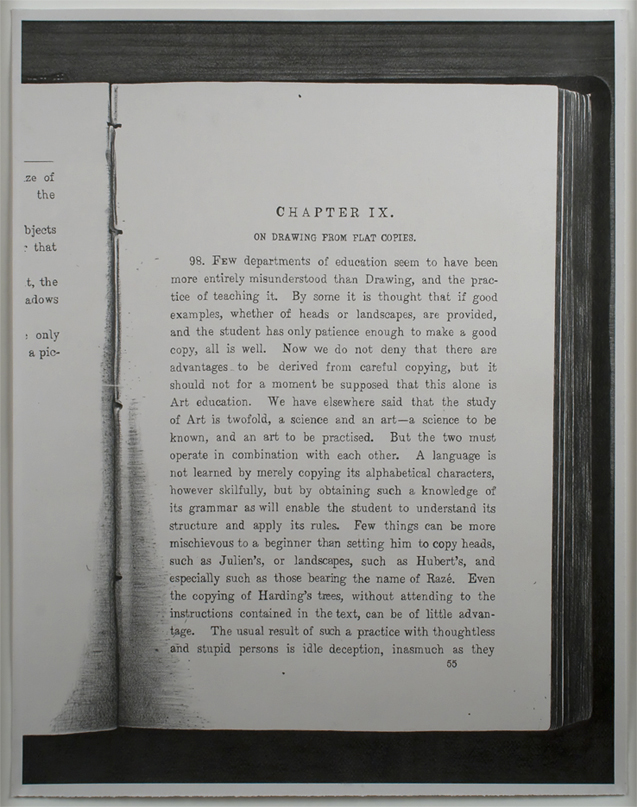
Molly Springfield’s Chapter IX from 2008 first appears to be a careless photocopy of a dry academic text: haphazardly cropped and poorly executed, the gutter is overly saturated with toner and the scanning bed is visible around the book’s edges. But close looking quickly belies this pretense. After noting the sheet’s neat border, we begin to observe the telltale signs of a work of graphite on paper: the burnished quality of the darkest areas, the subtle grain of the fine quality paper visible in the lighter strokes. This work is an original masquerading as a copy, a skilled drawing painstakingly rendered by hand and displayed in a handsome frame, yet faithfully resembling a document created in haste for reference and destined for disposal. With an added wink to the viewer, Springfield’s photorealistic rendering allows us to read the text—a treatise on the practice of drawing from flat copies.
For several years Springfield has been preoccupied with depicting photocopied pages from books on art and philosophy. Her sources are carefully chosen for their relevance to shifting notions of mediated representation. Past projects have replicated photocopied editions of William Henry Fox Talbot’s The Pencil of Nature, Walter Benjamin’s “The Work of Art in the Age of Mechanical Reproduction,” and Sol LeWitt’s “Sentences on Conceptual Art.” The present work is part of a series titled “Drawings about Drawing.” The text is an excerpt from the obscure late nineteenth-century British Handbook of Drawing by William Walker, a contemporary of John Ruskin’s (whose 1857 The Elements of Drawing provides the source for the second work in the series). This series continues Springfield’s exploration of the interchange between writing and drawing, reading and viewing, theory and practice. Ultimately, her work prompts questions regarding the traditional hierarchy of the precious (original) and the ephemeral (copy).
Around the same time that Walker and Ruskin were penning their works on the practice of drawing, a wave of cultural nostalgia for the handcrafted object was cresting across Europe and America. The Industrial Revolution was ushering in the age of mass production, the backlash of which has been the ascendancy—especially in art—of the concept of ‘the original.’ Ensuing technologies from the twentieth century, including the photocopy, have contributed to our current culture of disposability by facilitating low-cost and low-quality reproduction. An object’s cultural value is often directly proportional to its rarity, and facsimiles are more valued the less they betray their status as such. The utilitarian black and white photocopy occupies the lowest rung on this representational ladder.
From the 1960s onward, conceptual artists began to subvert this logic, creating ephemeral works with quotidian media, like the photocopy, that defied commercial motives and concerns of uniqueness. On the one hand, Springfield pays homage to this ethos, by literally reproducing the words and works of artists such as Mel Bochner, Mary Kelly, and Adrian Piper, and by mimicking their chosen forms of distribution. Yet the artist’s own labor-intensive process has more in common with the work of a traditional draftsman than with the anti-materialist practice often associated with conceptual art.
In Springfield’s current investigation of “the historical trajectory of drawing instruction,”1 she professes an ambivalent relationship to Walker’s Victorian emphasis on rote draftsmanship. Why then enact it? Through Springfield’s process, Chapter IX manifests the cyclical tensions of both art and technology. Walker’s tenets of artistic instruction are as antiquated as the Xerox has now become in the era of the digital scan, and as the notion of the original in the wake of conceptual art. Yet we are constantly negotiating how to move forward without leaving anything behind.
Consider the chain of events by which Walker’s text is transmuted into the present work: originally composed by hand and published via the printing press, a version of which was then photocopied and finally manually re-transferred to the page. Is the final product a drawing or a document? Springfield offers a reproduction of the text equally legible to that of the book and the photocopy, and yet it is a distorted version as well. As we choose to ‘read’ or ‘view’ the work, the graphic marks slide between text and image; though we can read them as words, they have the physicality of depiction, not inscription.
1. Molly Springfield, “Drawings About Drawing,” http://www.mollyspringfield.com/section/47712_Drawings_About_Drawing.html.
Molly Springfield Biography